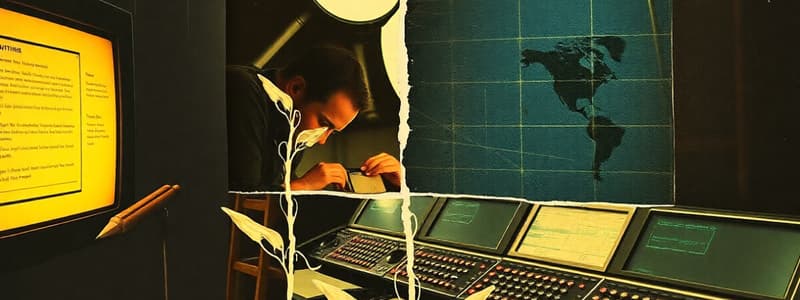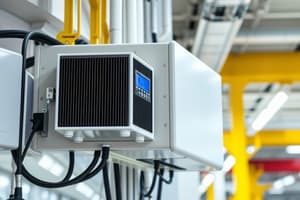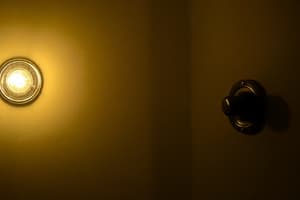Podcast
Questions and Answers
The ‘dress rehearsal’ is where actors rehearse with their costumes and all performance details are performed.
The ‘dress rehearsal’ is where actors rehearse with their costumes and all performance details are performed.
True (A)
The ‘Q-2-Q’ rehearsal is primarily for the performers to rehearse entire scenes.
The ‘Q-2-Q’ rehearsal is primarily for the performers to rehearse entire scenes.
False (B)
During the initial testing session, the lighting cues are verified for correct sequence using the cue sheet and instrument schedule.
During the initial testing session, the lighting cues are verified for correct sequence using the cue sheet and instrument schedule.
True (A)
Stage walkers are not involved in checking the focus during the initial testing session of the lighting cues.
Stage walkers are not involved in checking the focus during the initial testing session of the lighting cues.
The ‘dry tech’ rehearsal is only for actors to practice their lines without any technical cues.
The ‘dry tech’ rehearsal is only for actors to practice their lines without any technical cues.
The ‘dry tech’ rehearsal includes participation from the lighting operator and is primarily for testing technical cues.
The ‘dry tech’ rehearsal includes participation from the lighting operator and is primarily for testing technical cues.
During a ‘Q-2-Q’ rehearsal, actors primarily rehearse their entire scenes.
During a ‘Q-2-Q’ rehearsal, actors primarily rehearse their entire scenes.
Stage walkers are involved in the Q-2-Q rehearsals to assist with technical focus checking.
Stage walkers are involved in the Q-2-Q rehearsals to assist with technical focus checking.
The dress rehearsal allows cast members to practice with costumes and use props and backdrops.
The dress rehearsal allows cast members to practice with costumes and use props and backdrops.
The first testing session after entering lighting cues involves checking for defective equipment.
The first testing session after entering lighting cues involves checking for defective equipment.
Lighting designers do not participate in any of the testing sessions.
Lighting designers do not participate in any of the testing sessions.
The lighting cues are recorded in a cue sheet and the instrument schedule is not typically referenced.
The lighting cues are recorded in a cue sheet and the instrument schedule is not typically referenced.
A stage manager is not involved in the dry tech rehearsal.
A stage manager is not involved in the dry tech rehearsal.
The testing of lighting cues includes identifying and resolving potential issues before performances.
The testing of lighting cues includes identifying and resolving potential issues before performances.
The Q-2-Q rehearsal typically only includes audio technicians.
The Q-2-Q rehearsal typically only includes audio technicians.
Flashcards are hidden until you start studying
Study Notes
Lighting Control Testing Sessions
- Testing begins after all lighting cues are entered into the control console.
- First testing checks the proper sequence of cues against the cue sheet and instrument schedule.
- Essential to ensure that channels and dimmer circuits are correctly patched.
- Involves 'stage walkers' to verify focus and lighting effects.
- Participation includes the lighting designer, stage manager, and director.
- Identifies and rectifies wrongly entered cues and patching issues early on.
- This initial test is commonly referred to as the ‘dry tech’ rehearsal.
Q-2-Q Rehearsals
- Q-2-Q stands for 'cue to cue' rehearsals, focused on technical aspects for lighting and audio technicians.
- Typically attended by technicians and may include actors or speakers.
- Does not involve full scene rehearsals; focuses solely on technical cues.
- Aims to rehearse timings for turning lights on and off and to troubleshoot potential issues.
Dress Rehearsals
- Full-scale rehearsal where cast members wear their costumes.
- Actors perform every detail of the performance in a run-through.
- May utilize props and backdrops as required by the lighting designer.
- Important for final adjustments and ensuring that all elements of the performance come together seamlessly.
Lighting Control Testing Sessions
- Testing begins after all lighting cues are entered into the control console.
- First testing checks the proper sequence of cues against the cue sheet and instrument schedule.
- Essential to ensure that channels and dimmer circuits are correctly patched.
- Involves 'stage walkers' to verify focus and lighting effects.
- Participation includes the lighting designer, stage manager, and director.
- Identifies and rectifies wrongly entered cues and patching issues early on.
- This initial test is commonly referred to as the ‘dry tech’ rehearsal.
Q-2-Q Rehearsals
- Q-2-Q stands for 'cue to cue' rehearsals, focused on technical aspects for lighting and audio technicians.
- Typically attended by technicians and may include actors or speakers.
- Does not involve full scene rehearsals; focuses solely on technical cues.
- Aims to rehearse timings for turning lights on and off and to troubleshoot potential issues.
Dress Rehearsals
- Full-scale rehearsal where cast members wear their costumes.
- Actors perform every detail of the performance in a run-through.
- May utilize props and backdrops as required by the lighting designer.
- Important for final adjustments and ensuring that all elements of the performance come together seamlessly.
Studying That Suits You
Use AI to generate personalized quizzes and flashcards to suit your learning preferences.




